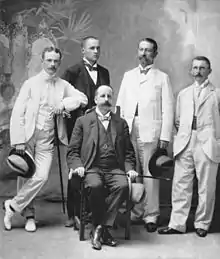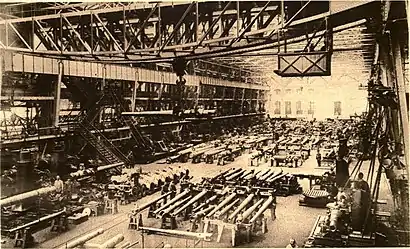Gustav Krupp von Bohlen und Halbach
Gustav Georg Friedrich Maria Krupp von Bohlen und Halbach (born Gustav von Bohlen und Halbach; 7 August 1870 – 16 January 1950) was a German foreign service official who became chairman of the board of Friedrich Krupp AG, a heavy industry conglomerate, after his marriage to Bertha Krupp, who had inherited the company. He and his son Alfried would lead the company through two world wars, producing almost everything for the German war machine from U-boats, battleships, howitzers, trains, railway guns, machine guns, cars, tanks, and much more. Krupp produced the Tiger I tank, Big Bertha and the Paris Gun, among other inventions, under Gustav. Following World War II, plans to prosecute him as a war criminal at the 1945 Nuremberg Trials were dropped because by then he was bedridden, senile, and considered medically unfit for trial. The charges against him were held in abeyance in case he were found fit for trial.[1]
Gustav Krupp von Bohlen und Halbach | |
|---|---|
 Gustav Krupp in 1915 | |
| Born | 7 August 1870 |
| Died | 16 January 1950 (aged 79) |
| Alma mater | University of Heidelberg |
| Occupation(s) | Chairman of the board of Friedrich Krupp AG, 1909–1945 |
| Spouse | Bertha Krupp |
| Children | Alfried Krupp |
| Signature | |
Early life

Gustav Krupp von Bohlen und Halbach was born Gustav von Bohlen und Halbach in The Hague in 1870.[2] He was a grandson of Henry Bohlen and related to Charles E. Bohlen and Karoline of Wartensleben. He married Bertha Krupp in October 1906. Bertha had inherited her family's company in 1902 at age 16 after the death of her father, Friedrich Alfred Krupp.[3] German Emperor Kaiser William II personally led a search for a suitable spouse for Bertha, as the Krupp empire could not be headed by a woman. Gustav was picked from his previous post at the Vatican.[3][4] The Kaiser announced at the wedding that Gustav would be allowed to add the Krupp name to his own. Gustav became company chairman in 1909.[3]
After 1910, the Krupp company became a member and major funder of the Pan-German League (Alldeutscher Verband) which mobilised popular support in favour of two army bills, in 1912 and 1913, to raise Germany's standing army to 738,000 men.
World War I

By World War I, the company had a near monopoly in heavy arms manufacture in Germany. At the start of the war, the company lost access to most of its overseas markets, but this was more than offset by increased demand for weapons by Germany and her allies (Central Powers). In 1902, before Krupp's marriage, the company leased a fuse patent to Vickers Limited of the United Kingdom. Among the company's products was a 94-ton howitzer named Big Bertha, after Krupp's wife, and the Paris Gun.[5] Gustav also won the lucrative contract for Germany's U-boats, which were built at the family's shipyard in Kiel. Krupp's estate, the Villa Hügel, had a suite of rooms for Wilhelm II whenever he came to visit.
Interwar years


During the occupation of the Ruhr in 1923, a French military court had Krupp imprisoned for seven months until the German government stopped their politics of passive resistance.
The Versailles Treaty prevented Germany from making armaments and submarines, forcing Krupp to significantly reduce his labour force. His company diversified to agricultural equipment, vehicles and consumer goods. However, using the profits from the Vickers patent deal and subsidies from the Weimar government, Krupp secretly began the rearming of Germany with the ink barely dry on the treaty of Versailles. It secretly continued to work on artillery through subsidiaries in Sweden, and built submarine pens in the Netherlands. In the 1930s, it restarted manufacture of tanks such as the Tiger I and other war materials, again using foreign subsidiaries.
Krupp was a member of the Prussian State Council from 1921 to 1933. Krupp was an avowed monarchist, but his first loyalty was to whoever held power. He once left a business meeting in disgust when another industrialist, who was the one hosting the meeting, referred to the late President Friedrich Ebert as "that saddlemaker" (Der Sattelhersteller).
Krupp initially opposed the Nazis, yet at the secret meeting with Adolf Hitler and leading German industrialists on February 20, 1933, he contributed one million Reichsmark to the Nazi party's fund for the March 1933 election, which enabled Hitler to take control of the government. After Hitler won power, Krupp became, as Fritz Thyssen later put it, "a super Nazi",[6] and contributed to the Adolf Hitler Fund of German Trade and Industry which was established in June 1933 to support the NSDAP. As president of the Reichsverband of German industry he led the effort to expel its Jewish members.[7]
Like many German nationalists, Krupp believed that the Nazis could be used to end the Republic, and then be pushed aside to restore the Kaiser and the old elites. When all parties were abolished and civil liberties suspended following the Reichstag fire and Hitler's grab for absolute power, Krupp found that he and the rest of the old elites were in the grip of the Party; the movement they had hoped to ride back into power upon had instead ridden them. Always flexible, Krupp cooperated with the new dictatorship.
I wanted and had to maintain Krupp, in spite of all opposition, as an armament plant for the later future, even if in camouflaged form. I could only speak in the smallest, most intimate circles about the real reasons which made me undertake the changeover of the plants for certain lines of production for I had to expect that many people would not understand me
— Krupp in an interview for Krupp magazine on 1 March 1942[8]
Hitler had tried to gain entry to the Krupp factories in 1929, but was rebuffed because Krupp felt he would see some of the secret armament work there and reveal it to the world. Bertha Krupp never liked Hitler even though she never complained when the company's bottom line rose through the armaments contracts and production. She referred to him as "that certain gentleman" (Dieser gewisse Herr) and pleaded illness when Hitler came on an official tour in 1934. Her daughter Irmgard acted as hostess.[4]
World War II
.jpg.webp)
Krupp suffered failing health from 1939 onwards, and a stroke left him partially paralysed in 1941. He became a figurehead until he formally handed over the running of the business to his son Alfried in 1943.[4] Krupp industries, under both his leadership and later that of his son, was offered facilities in eastern Europe and made extensive use of forced labor during the war.[9]
On 25 July 1943 the Royal Air Force attacked the Krupp Works with 627 heavy bombers, dropping 2,032 long tons of bombs in an Oboe-marked attack. Upon his arrival at the works the next morning, Krupp suffered a fit from which he never recovered.[10]
Nuremberg Trials
Following the Allied victory, plans to prosecute Gustav Krupp as a war criminal at the 1945 Nuremberg Trials were dropped because by then he was bedridden and senile. Despite his personal absence from the prisoners' dock, however, Krupp remained technically still under indictment and liable to prosecution in subsequent proceedings.[1][11]
Death
Krupp died at his residence near Werfen, Salzburg in Austria on 16 January 1950.[2] His widow died in 1957.[12] He had eight children including Alfried Krupp von Bohlen und Halbach (1907–1967), the last owner of Krupp (succeeded by his Alfried Krupp von Bohlen und Halbach Foundation).
See also
References
- "Krupp Ill, U.S. Seeks to Indict Son. British Ask Absentia Trial of Father". New York Times. November 13, 1945. Retrieved 2013-12-24.
Implications that Gustav Krupp von Bohlen und Halbach is not and never will be physically available for trial with the other major German war criminals ...
- "Gustav Krupp von Bohlen und Halbach". Trial Watch. 2008. Archived from the original on 2009-05-18. Retrieved 2008-10-01.
- "Gustav Krupp von Bohlen und Halbach". britannica. 2008. Retrieved 2008-10-01.
- Manchester, William. The Arms of Krupp. Boston: Little, Brown, & Company, 1968.
- Gerald V. Bull (Author), Charles H. Murphy (Author) (1988). Paris Kanonen-The Paris Guns (Wilhelmgeschutze and Project Harp : the Application of Major Calibre Guns to Atmospheric and Space Research) (May 1991 ed.). Presidio Press. p. 246. ISBN 3-8132-0304-2.
{{cite book}}:|last=has generic name (help) - Shirer, William. The Rise and Fall of the Third Reich. New York City: Simon & Schuster, 1960.
- Gustav Krupp von Bohlen und Halbach at Encyclopædia Britannica
- "Gustav Krupp von Bohlen und Halbach". jewishvirtuallibrary. 2007. Retrieved 2008-10-01.
- "GUSTAV KRUPP VON BOHLEN UND HALBACH". United States Holocaust Memorial Museum, Washington, D.C. May 20, 2008. Retrieved 2008-10-01.
- Gunston, Bill (2004-01-15). Night Fighters: A Development and Combat History: A Development and Combat History. The History Press. ISBN 9780752495125.
- Clapham, Andrew (2003). "Issues of complexity, complicity and complementarity: from the Nuremberg Trials to the dawn of the International Criminal". In Philippe Sands (ed.). From Nuremberg to the Hague: the future of international criminal justice. Cambrifge University Press. p. 37. ISBN 0-521-82991-7.
The tribunal's eventual decision was that Gustav Krupp could not be tried because of his condition but that 'the charges against him in the Indictment should be retained for trial thereafter if the physical and mental condition of the defendant should permit'.
- "Frau Krupp Dies In Germany At 71. Ex-Head of Munition Works Was Bertha for Whom Big Gun of '18 Was Named". New York Times. September 22, 1957. Retrieved 2013-12-24.